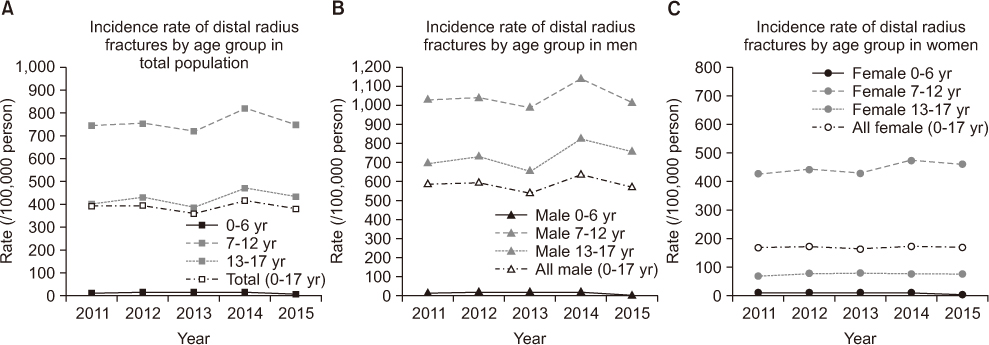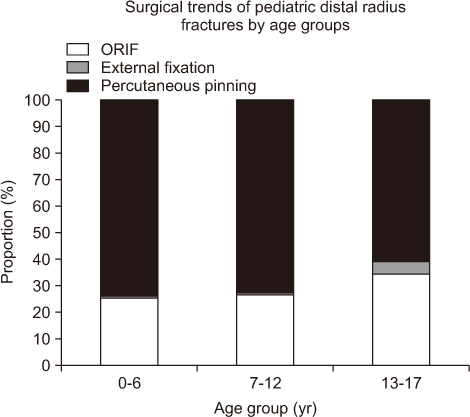Arch Hand Microsurg.
2017 Dec;22(4):217-223. 10.12790/ahm.2017.22.4.217.
Treatment Trends of Pediatric Distal Radius Fractures: A Population-Based Study in South Korea
- Affiliations
-
- 1Department of Orthopaedic Surgery, Hanyang University College of Medicine, Seoul, Korea. leegh@hanyang.ac.kr
- 2Department of Orthopaedic Surgery, Myongji Hospital, Goyang, Korea.
- KMID: 2406124
- DOI: http://doi.org/10.12790/ahm.2017.22.4.217
Abstract
- PURPOSE
To investigate treatment trends for pediatric distal radius fractures (DRFs) in Korea.
METHODS
We analyzed a nationwide database spanning 2011 to 2015 acquired from the Korean Health Insurance Review and Assessment Service. International Classification of Diseases, 10th revision (ICD-10) codes and procedure codes were used to identify patients aged under 18 years with newly diagnosed DRFs.
RESULTS
A total of 181,218 DRFs occurred from 2011 to 2015. Most of the DRFs (92.2%) were managed with conservative methods. Surgical fixation was performed on 14,219 DRFs (7.8%), the proportion of DRFs treated by surgical fixation was not significantly changed by the year (p=0.33). Among the patients who underwent surgical fixation, closed pinning (9,664 DRFs, 68.0%) was the most popular procedure. The proportion of DRF cases treated with open reduction and internal fixation (ORIF), however, tended to increase steadily over time (p < 0.001). Regarding surgical trend according to age group, as age increased the proportion of ORIF increased and closed pinning tended to decrease.
CONCLUSION
In Korea, most of pediatric DRFs were managed with conservative methods. In surgical fixation, closed pinning was the most popular procedure. However, the proportion of ORIF tended to increase steadily year by year.
Keyword
MeSH Terms
Figure
Reference
-
1. Rennie L, Court-Brown CM, Mok JY, Beattie TF. The epidemiology of fractures in children. Injury. 2007; 38:913–922.
Article2. Cheng JC, Ng BK, Ying SY, Lam PK. A 10-year study of the changes in the pattern and treatment of 6,493 fractures. J Pediatr Orthop. 1999; 19:344–350.
Article3. Wilkins KE. Principles of fracture remodeling in children. Injury. 2005; 36:Suppl 1. A3–A11.
Article4. Rodríguez-Merchán EC. Pediatric fractures of the forearm. Clin Orthop Relat Res. 2005; (432):65–72.
Article5. Miller BS, Taylor B, Widmann RF, Bae DS, Snyder BD, Waters PM. Cast immobilization versus percutaneous pin fixation of displaced distal radius fractures in children: a prospective, randomized study. J Pediatr Orthop. 2005; 25:490–494.6. McLauchlan GJ, Cowan B, Annan IH, Robb JE. Management of completely displaced metaphyseal fractures of the distal radius in children. A prospective, randomised controlled trial. J Bone Joint Surg Br. 2002; 84:413–417.7. Jo YH, Lee BG, Kim JH, et al. National surgical trends for distal radius fractures in Korea. J Korean Med Sci. 2017; 32:1181–1186.
Article8. Mattila VM, Huttunen TT, Sillanpää P, Niemi S, Pihlajamäki H, Kannus P. Significant change in the surgical treatment of distal radius fractures: a nationwide study between 1998 and 2008 in Finland. J Trauma. 2011; 71:939–942. discussion 942-3.
Article9. Wilcke MK, Hammarberg H, Adolphson PY. Epidemiology and changed surgical treatment methods for fractures of the distal radius: a registry analysis of 42,583 patients in Stockholm County, Sweden, 2004–2010. Acta Orthop. 2013; 84:292–296.10. Helenius I, Lamberg TS, Kääriäinen S, Impinen A, Pakarinen MP. Operative treatment of fractures in children is increasing. A population-based study from Finland. J Bone Joint Surg Am. 2009; 91:2612–2616.11. Randsborg PH, Sivertsen EA. Distal radius fractures in children: substantial difference in stability between buckle and greenstick fractures. Acta Orthop. 2009; 80:585–589.
Article12. Boutis K, Willan A, Babyn P, Goeree R, Howard A. Cast versus splint in children with minimally angulated fractures of the distal radius: a randomized controlled trial. CMAJ. 2010; 182:1507–1512.
Article13. Hove LM, Brudvik C. Displaced paediatric fractures of the distal radius. Arch Orthop Trauma Surg. 2008; 128:55–60.
Article14. Eismann EA, Little KJ, Kunkel ST, Cornwall R. Clinical research fails to support more aggressive management of pediatric upper extremity fractures. J Bone Joint Surg Am. 2013; 95:1345–1350.
Article15. Choi KY, Chan WS, Lam TP, Cheng JC. Percutaneous Kirschner-wire pinning for severely displaced distal radial fractures in children. A report of 157 cases. J Bone Joint Surg Br. 1995; 77:797–801.
Article16. Bae DS. Pediatric distal radius and forearm fractures. J Hand Surg Am. 2008; 33:1911–1923.
Article17. Hassan N, Noor F, Ahmad S, Fazili KM. Age of fusion of the distal radial and ulnar epiphyses from hand radiographs-A study in Kashmiri population. Sci Justice. 2016; 56:431–436.
Article18. Larsen E, Vittas D, Torp-Pedersen S. Remodeling of angulated distal forearm fractures in children. Clin Orthop Relat Res. 1988; (237):190–195.
Article19. Grewal R, MacDermid JC, King GJ, Faber KJ. Open reduction internal fixation versus percutaneous pinning with external fixation of distal radius fractures: a prospective, randomized clinical trial. J Hand Surg Am. 2011; 36:1899–1906.
Article



